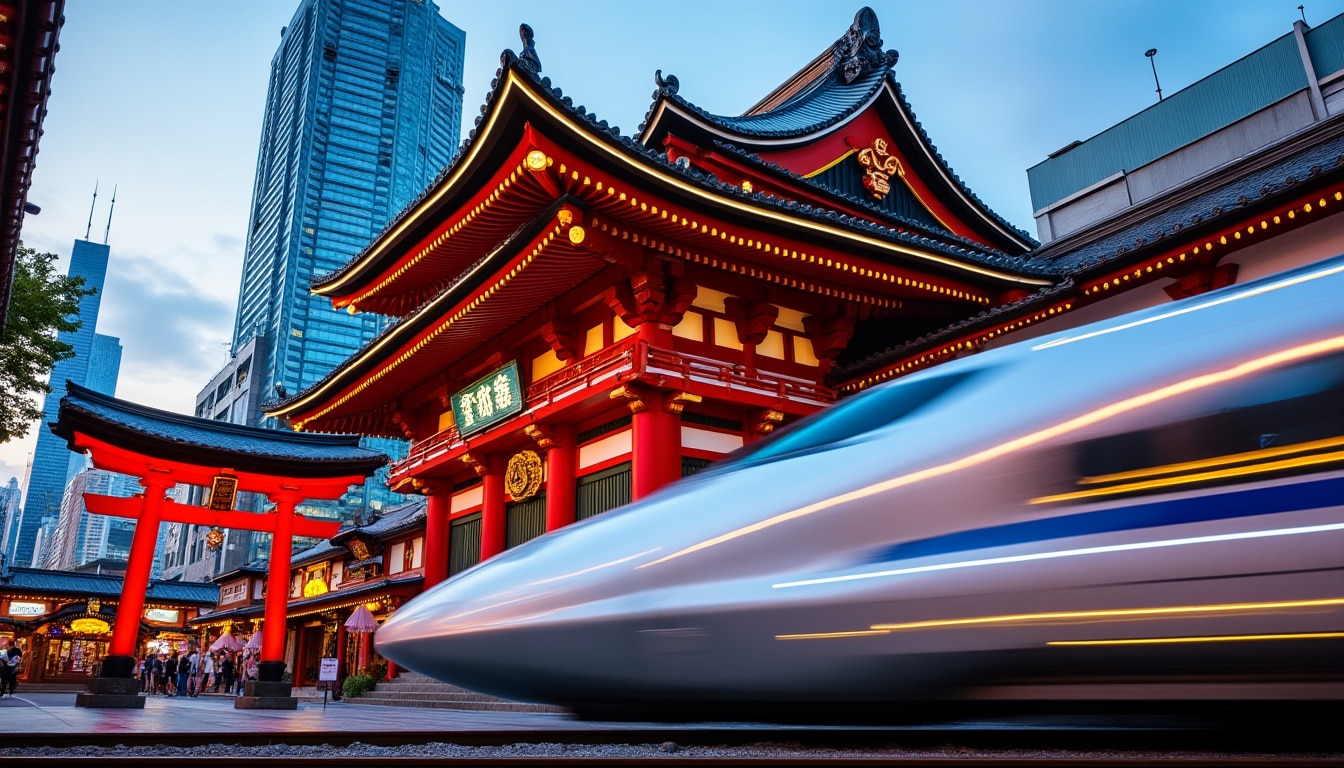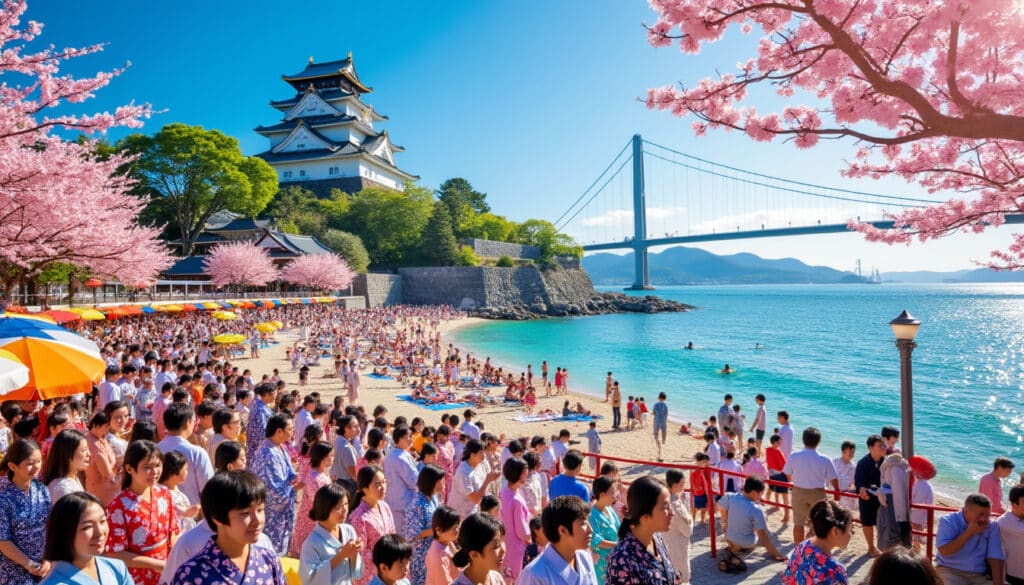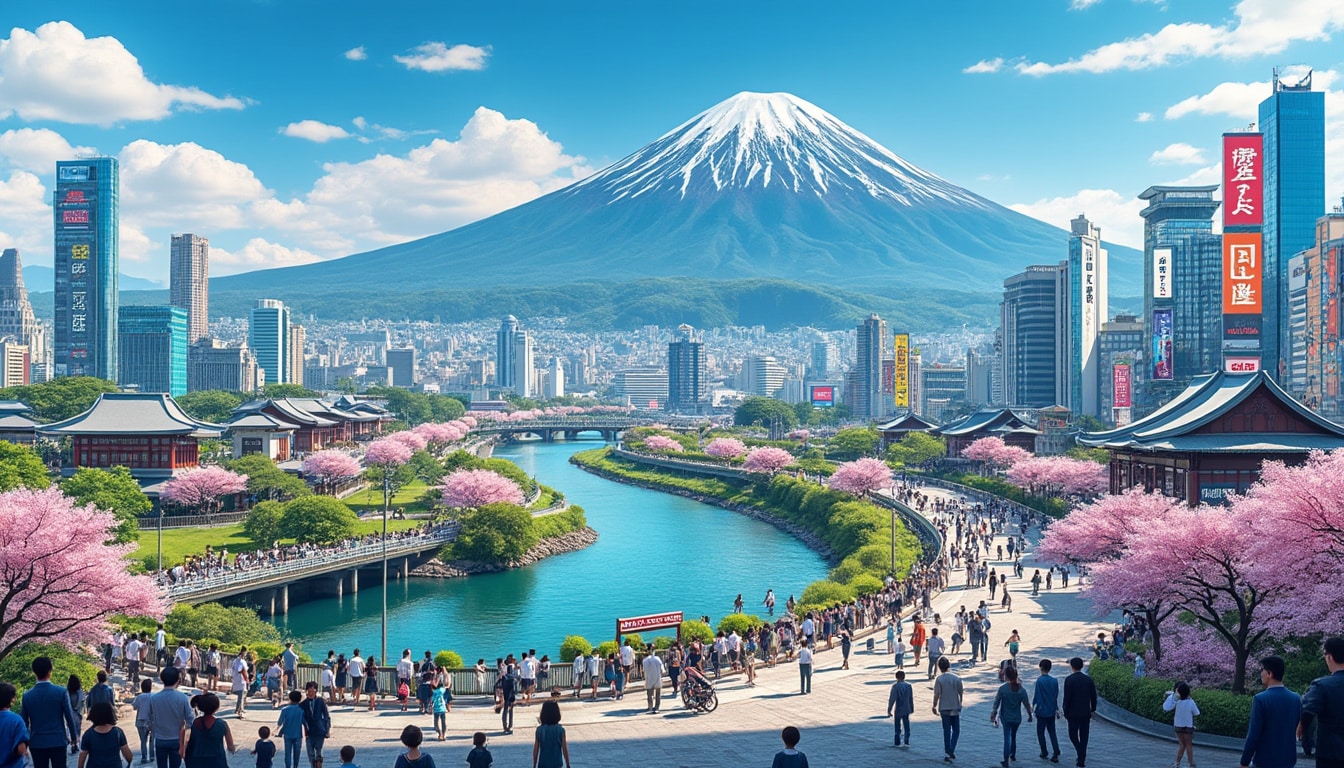Chiba, a vibrant prefecture situated in the heart of Japan, offers a fascinating glimpse into the interplay of population dynamics and geographic diversity. With its unique position neighboring Tokyo and extending to the Pacific Ocean, Chiba’s demographic landscape is continuously evolving. The region harbors a rich cultural tapestry and serves as a bustling hub for commerce, technology, and natural beauty. The region’s noteworthy landmarks, educational institutions, and renowned sports teams contribute significantly to its identity. This detailed examination of Chiba’s demographics and geography unveils a region of significant importance, whose residents, infrastructure, and attractions form a compelling narrative of progress and tradition.
Population Trends and Statistics in Chiba
Chiba prefecture, with its sprawling urban centers and serene rural landscapes, is home to over 6.2 million people as of the latest 2020 census. The population of Chiba City alone has shown remarkable growth, maintaining its status as the largest city within the prefecture. The city has grown from 856,878 residents back in 1995 to a robust 974,951, reflecting its urban expansion and economic vitality.
The gender distribution in Chiba mirrors national averages, with a slight skew towards females, who comprise approximately 50.7% of the population. The age distribution is equally telling, with the largest segment, about 544,888 individuals, between the ages of 18 and 64. Meanwhile, those over 65 years account for nearly a quarter of the population, signifying an aging demographic that could influence future economic and social policies.
The population’s composition further breaks down by age groups, notably with a significant younger population. While the 0-17 years category consists of 135,928 individuals, there is a noticeable concentration of individuals in their productive years between the ages of 20-49. This could potentially foster innovation, drive academia, and support the region’s technology sector epitomized by institutions like the Chiba Institute of Technology.
Key Demographic Highlights:
- 👨 Males: 481,246
- 👩 Females: 493,705
- 👶 Age 0-17: 135,928
- 🧔 Age 18-64: 544,888
- 👵 Age 65+: 249,963
Moreover, Chiba’s population includes a small but significant group of foreign nationals, accounting for over 23,000 residents. This multicultural facet enriches the cultural milieu of the prefecture, fostering a diverse community tapestry that is seen in various cultural festivals and local events.
The continuous population growth, demographic shifts towards an aging society, and a diverse age range make Chiba an intriguing case study in urban planning and community development strategies.

The Role of Urbanization in Population Dynamics
Urbanization has played a pivotal role in shaping Chiba’s demographic profile. The city’s proximity to Tokyo has facilitated this growth, attracting a workforce keen on leveraging the economic opportunities in the capital while enjoying more affordable living options in Chiba. Cities like Funabashi and Ichikawa have seen substantial increases in their population, as detailed in census data over the decades.
Chiba’s urban infrastructure includes the Chiba Urban Monorail, a critical transit system that supports daily commutes and facilitates efficient movement within and between cities. This physical connectivity, coupled with strategic urban planning, aids cities like Chiba in handling demographic pressures, minimizing congestion, and ensuring sustainable development.
Geographic Features and Natural Landmarks of Chiba
Chiba’s geographic features are as diverse as its demographic profile. The prefecture is characterized by its extensive Pacific coastline, providing ample opportunities for marine activities and making it a prime location for both tourism and local recreation. The Chiba Marine Stadium, home to the popular Chiba Lotte Marines, is a landmark that merges the love of outdoor sports with the beauty of coastal scenery.
Geographical diversity within Chiba encompasses flat plains, rolling hills, and a network of rivers that create a rich agricultural sector known for producing delicious peanuts and rice. This diverse terrain not only supports agriculture but also enhances the scenic beauty that attracts tourists and nature lovers alike.
Prominent geographic sites include the Cape Inubōsaki, known for its majestic lighthouse, and the Kujukuri Beach, a 60-kilometer stretch that is one of Japan’s longest, offering a vast arena for beachgoers and water sports enthusiasts. Aqua Park Chiba further supplements this natural allure, incorporating contemporary leisure facilities that appeal to families and tourists.
Significant Landmarks and Geographic Highlights:
- 🌄 Cape Inubōsaki Lighthouse
- 🏖️ Kujukuri Beach
- 🏟️ Chiba Marine Stadium
- 🏞️ Aqua Park Chiba
- 🌿 Chiba Prefectural Boso-no-Mura
Environmental Stewardship and Sustainable Initiatives
As urban expansion continues, balancing growth with environmental stewardship is paramount. Chiba has made significant strides in sustainable urban development, incorporating green spaces into city planning, and promoting sustainable tourism. Initiatives aimed at preserving coastal ecosystems and the rejuvenation of urban parks are underway, supported by institutions like the Chiba City Museum of Science and the Chiba Prefectural Museum of Art, which highlight both scientific education and cultural heritage.
Cultural and Economic Factors Shaping Chiba
Chiba’s economy is diverse, combining industrial prowess with cultural vitality. The presence of manufacturing sectors and high-tech industries fuels economic growth, while cultural venues and events ensure a vibrant social scene. The Chiba Shinkansen Line plays a significant role in bridging economic hubs between Tokyo and Chiba, facilitating business operations and fostering economic ties.
Educational institutions such as the Chiba Institute of Technology and the University of Chiba are pivotal in driving research, development, and innovation, nurturing a skilled workforce that caters to technological and scientific advancements. This educational foundation supports industries and enhances Chiba’s appeal as a knowledge hub.
Additionally, the prefecture’s cultural landscape is enriched by its historical sites, festivals, and local cuisine that reflect a blend of tradition and modernity. Events such as the Naritasan Gion Matsuri and the Sawara Grand Festival attract visitors, showcasing traditional Japanese culture, music, and dance.
Cultural and Economic Pillars:
- 🏭 Industrial sectors and high-tech industries
- 🎓 Chiba Institute of Technology
- 🚅 Chiba Shinkansen Line
- 🎉 Naritasan Gion Matsuri
- 🍣 Local Chiba cuisine
Chiba actively leverages its cultural and economic strengths, promising sustainable growth and a thriving community life that attracts both residents and visitors.
Sports and Entertainment Influences
Sports play a crucial role in Chiba, adding to its vibrant energy. The Chiba Lotte Marines, a professional baseball team, enjoys a large following and enhances community spirit. Chiba Marine Stadium frequently hosts thrilling matches, bringing residents and visitors together in celebration of sportsmanship.
Entertainment options abound in Chiba, offering a mix of leisure and cultural engagements. The Chiba Port Tower provides panoramic views of the city, while entertainment hubs like Makuhari Messe host concerts, exhibitions, and conventions, attracting global attention and participation.
Future Prospects and Development Goals for Chiba
As Chiba looks to the future, strategic development plans focus on sustainable growth and infrastructure advancement. The prefecture aims to enhance its transportation networks, improve living standards, and preserve its natural beauty. Initiatives include expanding the Chiba Urban Monorail and further integrating technology within daily life, aiming for a smart city transformation.
Technological integration not only supports economic initiatives but also enhances environmental conservation efforts. With continued investment in green technology and educational initiatives spearheaded by institutions like the Chiba City Museum of Science, Chiba is positioned to lead in ecological sustainability.
Moreover, Chiba is committed to fostering a robust community by enhancing health services, promoting cultural interactions, and expanding its role as a regional educational center. These development goals encapsulate the prefecture’s vision for balanced growth and improved quality of life.
Development Priorities:
- 🚇 Expansion of Chiba Urban Monorail
- 🏡 Improved living standards
- 🌱 Green technology initiatives
- 🧑🏫 Educational excellence
- 🌆 Smart city transformation
The future of Chiba rests on the seamless amalgamation of innovation, tradition, and sustainable practices, paving the way for a dynamic and prosperous prefecture.
Possible Challenges and Solutions
While Chiba’s development outlook is promising, potential challenges include managing an aging population, sustaining economic growth, and integrating technological advancements equitably. Solutions lie in robust policy frameworks that emphasize inclusive growth, support for the elderly, and continuous investment in education and industry-specific skills development.
Engaging with global networks for technology transfers and forging international partnerships further bolster Chiba’s capacity to navigate future challenges and seize opportunities across economic and cultural domains.
FAQs About Chiba
Here are some commonly asked questions and answers about Chiba to help you understand this dynamic prefecture better:
- What are some major cultural attractions in Chiba? – Visitors can explore the Chiba Prefectural Museum of Art, Naritasan Shinshoji Temple, and attend festivals like the Sawara Grand Festival.
- How does public transportation connect Chiba with Tokyo? – The Chiba Shinkansen Line and numerous railway services provide convenient access to Tokyo, enhancing connectivity for commuters and travelers.
- What natural attractions does Chiba offer? – Chiba boasts diverse landscapes including Kujukuri Beach, Cape Inubōsaki, and various parks and reserves offering hiking and outdoor activities.
- Which industries primarily drive Chiba’s economy? – The economy is driven by manufacturing, high-tech industries, and a strong service sector.
- How does Chiba promote sustainable development? – Through green technology initiatives, urban green spaces, and cultural heritage conservation projects.

Fun Facts & Curiosities About Chiba
🌟 Nestled on Japan’s eastern coastline, Chiba Prefecture is a hidden gem in the Land of the Rising Sun. Known for its rich blend of history, culture, and breathtaking landscapes, Chiba is more than just Tokyo’s neighbor. It offers captivating…

Architecture and urban features of Chiba
As a bustling city located just east of Tokyo, Chiba offers a rich tapestry of urban design and architecture that reflects both its historical legacy and modern innovations. The city boasts a diverse array of structures, from historical castles to…

Chiba is a fascinating prefecture that offers a unique blend of urban conveniences and natural beauty, nestled in proximity to the bustling metropolis of Tokyo. While it may not be as internationally renowned as its neighboring capital, Chiba has carved…

Located on the eastern coast of Honshu, Chiba Prefecture stands as a testament to Japan’s rich history and cultural evolution. Nestled in the impressive Kanto Plain, Chiba has been a witness to pivotal moments in time and the lives of…

Holidays and celebrations in Chiba
Chiba, a captivating blend of tradition and modernity, offers a unique cultural tapestry through its rich holidays and vibrant celebrations. From traditional matsuri (festivals) that honor historical roots to contemporary extravaganzas that light up the night sky, Chiba’s festivities capture…

Language and spelling of Chiba
Chiba, a vibrant prefecture bordering Tokyo, is not only a hub for tourists, but also for linguists interested in the interplay of language and culture. As an example of modern Japan, Chiba showcases an intriguing blend of traditional and contemporary…

Local tips for tourists in Chiba
Chiba Prefecture, located just east of Tokyo, is renowned for its major international gateway, Narita Airport, but it holds many hidden treasures that offer a blend of both urban and rural experiences. From the enchanting allure of Tokyo Disney Resort…

Names, flags, and identity of Chiba
Chiba Prefecture, located on the eastern edge of Japan’s Honshu Island, is a region filled with vibrant history, cultural symbols, and distinct identity markers. Understanding Chiba requires delving into its rich tapestry of names and flags that symbolize its journey…

Reputation and identity of Chiba
Chiba, nestled in the vibrant Kanto region of Japan, boasts a distinct blend of tradition and modernity. As one navigates the cityscape, they’re greeted with an eclectic mix of the ancient and the new, where historic landmarks harmonize with cutting-edge…

Understanding the intricacies of time and time zones in Chiba, Japan, is essential for travelers and residents alike. Chiba, a vibrant city nestled close to Tokyo, operates on Japan Standard Time (JST), which is 9 hours ahead of Coordinated Universal…

Unusual facts and social issues in Chiba
Chiba Prefecture, nestled in the Kanto region of Japan, offers a treasure trove of unique facts and multifaceted social issues, making it a fascinating area of study. This vivid prefecture is known for its blend of lush greenery and bustling…

What does Chiba look, smell, feel like?
Chiba Prefecture, nestled next to the bustling metropolis of Tokyo, offers an intriguing mix of urban sophistication and rural charm. This Japanese region is renowned for its vibrant landscapes, rich history, and diverse attractions, making it a fascinating destination for…


